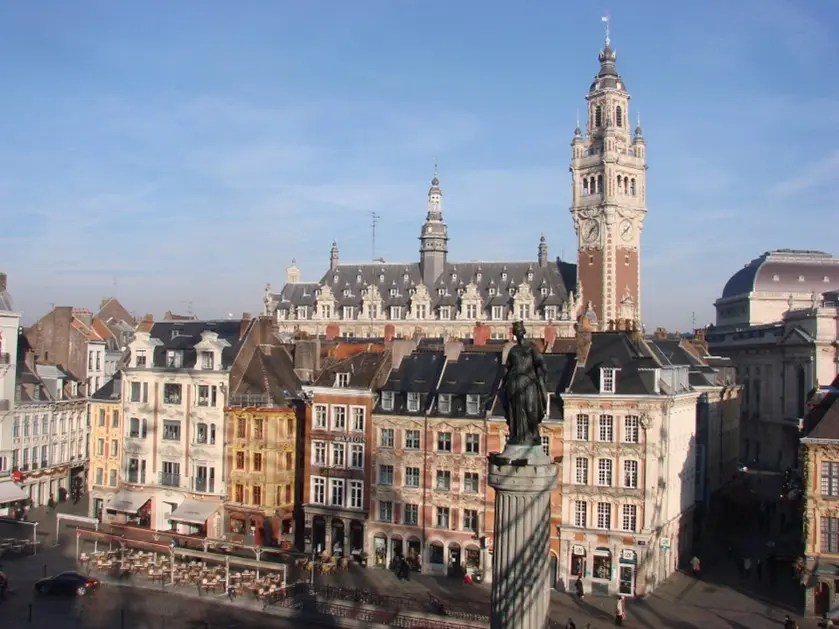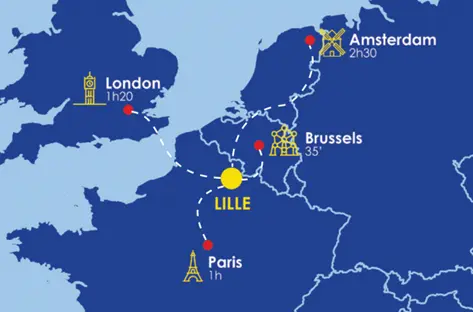About Lille
Lille is a vibrant and dynamic university city at the centre of Western Europe. With swift connections to Brussels (35 minutes), Paris (60 minutes), and London (80 minutes).
LILLE, A CITY OF ART, CULTURE AND HISTORY
Founded in 1066 by the Count of Flanders, Lille – Rijsel in Flemish – became an important trading and stock market point on the route between the rich Flemish towns and the Champagne fairs. As evident from some of its architecture, Lille was successively Flemish, Burgundian, and Spanish before finally becoming French in 1667 under Louis XIV, whose military engineer, Vauban, built Lille’s impressive Citadel.
Lille’s strategic location and the area’s rich resources have made it one of the most fought over regions in Europe, a history visible today particularly through the numerous memorials from the last two World Wars in the region, toured by national and international visitors each year. Lille can boast all the conveniences of being at the centre of a 2 million inhabitant urban zone, yet remains a “human-sized” university city with 250,000 inhabitants. Visitors can get around easily on foot or by bicycle. Public transport also offers the metro, the tramway, and many buses.

BIG CITY ADVANTAGE, SMALL CITY ATMOSPHERE
Lille is a cultural destination with much to offer. Art lovers stroll the Palais des Beaux Arts, home to the 2nd largest fine arts collection in France after the Louvre, the ancient Hospice Comtesse with works dating back to the 13th century, the Modern Art Museum, and La Piscine, located in a former art deco swimming pool in neighbouring Roubaix. Further afield, one can find world-renowned museums such as the Louvre-Lens Museum, which opened in 2013 to supplement the Louvre in Paris, and the Matisse Museum in Le Cateau-Cambresis, his hometown. Other galleries and museums abound. Lille also boasts a significant number of theatres, music halls, movie theatres, an opera house, and a national orchestra, while the metropolis is home to a large number of regular cultural events.
COMING TO LILLE
With its numerous rail, air and road connections, the capital of Flanders is easily accessible and benefits from a favourable geographical position at the crossroads of the major metropolises of North-Western Europe.

BY TRAIN
Situated just 500 metres from one another, Lille’s two train stations are located in the city centre and are served by both the subway and the tram.
Lille Flandres Station: TER regional trains and direct TGV service to Paris.
Lille Europe Station: Eurostar service to London and Brussels, direct TGV service to Roissy Airport, Paris and all major French cities.
BY PLANE
The Lille-Lesquin International Airport is located 10 km from Lille city centre.
Shuttle service from the airport to the city centre (bus stop sign “Liaison aéroport” in front of the Euralille shopping centre) is available. Length of ride: 20mn. https://www.flibco.com/en/shuttle/bus-lille-airport.
Paris and Brussels airports are conveniently connected to Lille within a 1-hour train ride.
BY CAR
Six motorways lead to Lille:
- A1 from Paris (220 km)
- A22 / E17 from Ghent (75 km), Antwerp (125 km) and Amsterdam (290 km)
- A23 from Valenciennes (53 km)
- A25 from Dunkerque (80 km) and the A26 from Calais (110 km)
- A27 / E42 from Brussels (110 km)
Eurotunnel Le Shuttle offers a fast and frequent service from Folkestone to Calais in just 35 minutes and with up to 4 shuttle departures an hour.
Lille is only an hour and a half drive from the Eurotunnel Calais Terminal on the A26 motorway. www.eurotunnel.com
BY BUS
BlablaBus (formerly OuiBus) and Flixbus offer regular routes to Lille.
The bus station is located next to the Lille Europe station in the centre of Lille.